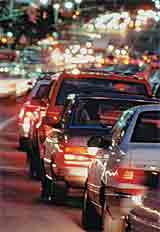Belt use on U.S. roads climbed to 82 percent in 2005, the second straight year the national rate has topped 80 percent. In fact, belt use has been trending upward for years, and much of the increase has resulted from stepped up publicity and enforcement of safety belt laws (see Status Report, Jan. 11, 2003; on the web at www.iihs.org).

But the trend doesn’t reflect the actual use rate around the clock. Rates are tracked by the National Highway Traffic Safety Administration, which surveys belt use from 8 a.m. to 4 p.m. -and use is known to be lower at night than during the day.
Fatal crash risk also is much higher per mile driven at night. Connecticut provides a good example. About 40 percent of all fatal passenger vehicle crashes in 2003 occurred at night. Yet only 10 percent of all driving on Connecticut roads occurred between 9 p.m. and 4 a.m.
“Is the higher death rate at night due in part to lower belt use? Or do unbelted drivers take more risks and get into more serious crashes? Research suggests that both are the case, which is why it’s so important to pay attention to belt use at night as well as during the day,” says Susan Ferguson, Institute senior vice president for research.
Studies in Connecticut and Pennsylvania: Two new studies from the Preusser Research Group, one conducted in Connecticut and the other in Pennsylvania, confirm the differences in belt use rates by time of day. The Connecticut study found nighttime use was 6 percentage points lower than the daytime rate, 77 versus 83 percent. This finding is based on observations of belt use at 100 sites during 2004. The researchers followed nearly identical procedures for the day and night observations, except that they used night vision goggles and hand-held infrared spotlights to collect the data between 9 p.m. and 4 a.m.
The researchers went a step further in Pennsylvania, working with police in Reading to step up enforcement of the safety belt law during nighttime hours. Numerous programs have used publicity and enforcement of such laws to boost daytime buckle-up rates. North Carolina set the example with “Click It or Ticket” (see Status Report, Nov. 15, 2001; on the web at www.iihs.org), but Reading’s program is one of the first to target unbelted motorists at night.
Officers in Reading used various enforcement methods including checkpoints, where night vision equipment helped the police observe belt use and ticket unbelted motorists. Radio and newspaper coverage plus other publicity warned of this enforcement program, which ran during September 2004.
A complication involved the Pennsylvania belt law itself, which allows for enforcement only if a driver is stopped first for another violation. Still, Reading police issued 42 tickets for not buckling up during the program plus another 225 warnings.
Belt use generally is lower in Reading than the United States at large, but the city’s enforcement program made a difference. Belt use during the day went from 56 percent before the program to 59 percent after, while the nighttime rate increased from 50 to 56 percent. Meanwhile, enforcement wasn’t beefed up in Bethlehem, Pennsylvania, where use rates didn’t change.
Challenge of nighttime enforcement: Observing whether motorists are using their belts at night is difficult except where there’s bright overhead lighting. Police in Reading used near-military grade night vision goggles to overcome this problem, but using such equipment to enforce traffic laws has sparked some controversy.
Last summer complaints about police spying on motorists in Maryland cut short the use of goggles to monitor belt use rates at night. Governor Robert Ehrlich ordered discontinuation of the goggles after only a threehour test.
“Still it’s important to find ways to boost belt use at night, and one way is to combine enforcement of belt laws with nighttime enforcement of DWI laws,” Ferguson says. For example, Institute researchers worked with police in Binghamton, New York, to conduct safety belt and DWI checkpoints. The result was a reduction in the proportion of drinking drivers and an increase in the belt use rate, especially the nighttime rate (see Status Report, Oct. 19, 1991).
“Connecticut’s day and night safety belt use” by N.K. Chaudhary et al. is on the web at www.nhtsa.dot.gov. “Evaluation of the Reading, Pennsylvania, nighttime safety belt enforcement campaign: September 2004” by N.K. Chaudhary et al. is in the Journal of Safety Research 36:321-26(2005).
Two more states upgrade belt laws to allow primary enforcement. One reason the belt use rate in Pennsylvania is lower than the U.S. average (see story, facing page) is that the state’s belt law is one of the weaker ones. It allows for secondary enforcement, under which police may not ticket motorists for this violation alone.
Legislators in Alaska and Mississippi recently upgraded their belt laws from secondary to primary enforcement. The new laws take effect in May. Then police may ticket motorists solely for belt violations. This brings to 25 the number of states that allow primary enforcement of safety belt laws.
The National Highway Traffic Safety Administration reports that buckle-up rates were 10 percentage points higher during 2005 -85 versus 75 percent-in states with primary laws. An Institute study estimates the lifesaving effects. Death rates declined an estimated 7 percent after belt laws in 9 states and the District of Columbia were changed during 1989-2003 to allow primary enforcement (see Status Report, Jan. 31, 2005; on the web at www.iihs.org).




